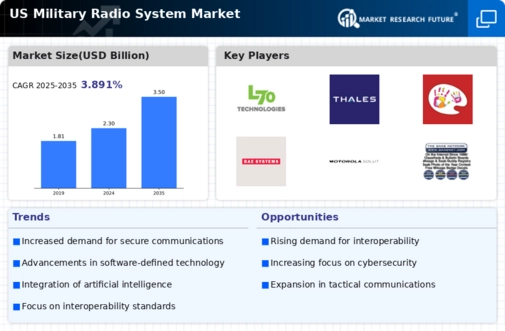The US Military Radio System Market is a critical component of defense communication infrastructure, serving as the backbone for tactical and strategic operations. This market encompasses a wide range of radio communication systems designed to ensure secure, reliable, and efficient communication among military personnel and equipment. Competitive insights in this market reveal a landscape characterized by rapid technological advancements, increasing demand for interoperability, and a strong emphasis on enhancing communication capabilities amid evolving warfare scenarios.
As nations prioritize modernization and adaptability in their military communication systems, the competitive dynamics in this space have intensified, driving innovation and investment from key players. The focus is not only on upgrading existing systems but also on developing next-generation technologies that meet the unique demands of military operations.L3 Technologies has established a formidable presence in the US Military Radio System Market, attributed to its comprehensive suite of communication solutions that cater to various defense missions. The company is recognized for its innovative technologies that enhance situational awareness and operational efficiency for military personnel.
L3 Technologies leverages its expertise in secure communications, ensuring that its radio systems are resilient against potential threats and capable of seamless integration with existing defense infrastructures. The strategic investments in research and development allow L3 Technologies to stay ahead of the curve in delivering cutting-edge radio technologies. Its strong partnerships with the Department of Defense and other governmental agencies further solidifies its position as a trusted provider of military communication solutions.
The company’s commitment to quality and dependability has made it a preferred choice for various military operations, enhancing mission success rates and overall effectiveness.Raytheon Technologies is another key player in the US Military Radio System Market, known for its advanced communication solutions that support a wide range of military applications. The company offers an array of products, including secure tactical radios and encrypted communications systems designed to operate in diverse environments and mission scenarios. Raytheon Technologies stands out for its emphasis on innovation, leveraging cutting-edge technologies to enhance the robustness and reliability of its military radio systems.
The company has engaged in strategic mergers and acquisitions to expand its portfolio and capabilities in the defense sector, allowing it to deliver comprehensive solutions that address the evolving requirements of modern warfare. With a significant market presence, Raytheon Technologies is well-positioned to meet the increasing demand for advanced communication systems within the US military. Its strong focus on research, combined with a track record of successful collaborations with various defense entities, underscores its competitive advantage in the military radio space, facilitating superior communication and operational efficiency for armed forces personnel.



















